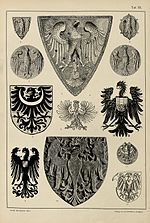Khvarenah (also spelled khwarenah or xwarra(h): Avestan: 𐬓𐬀𐬭𐬆𐬥𐬀𐬵 xᵛarənah) is an Avestan word for a Zoroastrian concept literally denoting "glory"...
15 KB (2,018 words) - 16:07, 1 May 2024
suggested that the figures used in Persian reliefs were meant to depict khvarenah or royal glory to reflect the perceived divine empowerment of kings, and...
13 KB (1,278 words) - 00:52, 29 June 2024
Faravahar, one of the primary symbols of Zoroastrianism, believed to be the depiction of a Fravashi or the Khvarenah....
158 KB (16,498 words) - 13:19, 11 August 2024
scholars as Ahura Mazda has been now speculated to represent the royal khvarenah, the personification of divine power and regal glory. However, it was...
34 KB (3,871 words) - 10:31, 27 July 2024
Iranian view, kings would never rule, unless Khvarenah is with them, and they will never fall unless Khvarenah leaves them. For example, according to the...
39 KB (5,295 words) - 01:00, 20 July 2024
figures, thus the investiture scene can be associated with the Avestan khvarenah, i.e. kingly glory. According to the modern historian Khodadad Rezakhani...
28 KB (3,097 words) - 11:23, 18 May 2024
ruled for a thousand years, starting from 100 years after Jam lost his Khvarenah, his royal glory (see Jamshid). He is described as a sorcerer who ruled...
31 KB (3,369 words) - 20:47, 30 July 2024
Parthian coins for the next 200 years. In later imagery, Tyche provides the Khvarenah or projection of divine rulership in Zoroastrianism to the worthy king...
18 KB (1,859 words) - 02:04, 22 July 2024
Arabic and Persian, among other languages. Derived from the concept of Khvarenah (divine radiance, halo) in Zoroastrianism[dubious – discuss], it has more...
7 KB (760 words) - 18:28, 13 July 2024
The Hōm is in addition the vehicle of farr(ah) (MP: khwarrah, Avestan: khvarenah, kavaēm kharēno) ("divine glory" or "fortune"). Farrah in turn represents...
21 KB (2,412 words) - 13:15, 24 July 2024
from his mother, his body will be sun-like, and the "royal glory" of the Khvarenah will be with him. Then, for the next 57 years he will subsist on only...
9 KB (1,125 words) - 09:42, 25 June 2024
to show himself as a worshiper of Mazda related to god and possessing khvarenah. The claim of the legitimacy of his reign as a rightful newcomer from...
95 KB (13,000 words) - 15:43, 28 July 2024
wreak mayhem, but forced back into the underworld by the divine glory (khvarenah) at sunrise. The Zoroastrianism of the medieval texts is unambiguous with...
32 KB (4,080 words) - 13:07, 22 April 2024
According to the Shahnameh, when Jamshid became proud of himself and lost his Khvarenah, Zahhak made the war upon Jamshid, and he was welcomed by many of Jamshid's...
2 KB (165 words) - 10:41, 23 July 2022
displayed, both Iranian aspects. The bird of prey was associated with the khvarenah, i.e. kingly glory. It was possibly also a symbol of the bird of the deity...
45 KB (4,943 words) - 21:37, 6 August 2024
Spityura battle Vohu Manah, Asha Vahishta and Atar for the possession of khvarenah. Later in the same hymn (19.96), Aka Manah is predicted to be in battle...
7 KB (998 words) - 12:41, 10 December 2023
When falsehood enters Yama's speech this golden age comes to an end. The Khvarenah "Royal Glory" departs from Yama and seeks refuge in the cosmic sea. Azhi...
43 KB (6,027 words) - 02:18, 5 July 2024
mythology, and later Zoroastrian philosophy, speaks of the similar concept of Khvarenah (later farrah), a divine, radiant power that sanctified a king and his...
41 KB (5,315 words) - 21:37, 13 July 2024
Shahrivar (Zoroastrian angel), and the Kiyani Khvarenah. With regards to the pre-Islamic Iranian concept of Khvarenah (glory), Suhrawardi mentions: "Whoever...
29 KB (3,721 words) - 14:36, 7 June 2024
Hellenistic iconography to portray their divine figures, thus the investiture scene can be associated with the Avestan khvarenah, i.e. kingly glory....
5 KB (442 words) - 19:14, 18 June 2023
Camfil Farr Farr, the Zoroastrian concept of God's favor, also called khvarenah Farr West, Utah, a US city This disambiguation page lists articles associated...
630 bytes (112 words) - 21:16, 4 April 2019
Empire of Persia. Eagle (or the related royal bird vareghna) symbolized khvarenah (the God-given glory), and the Achaemenid family was associated with eagle...
51 KB (6,089 words) - 00:05, 19 June 2024
characterisation of Tabiti being possibly linked to the notion of the khvarenah (Avestan: 𐬓𐬀𐬭𐬆𐬥𐬀𐬵, romanized: xᵛarᵊnah), the Iranian divine bliss...
13 KB (1,390 words) - 21:00, 15 April 2024
a bright farna," itself composed of: *xšaita-, "brilliant." *-farna, "khvarenah." *Šaϑraka Ancient Greek: Σατρακης, romanized: Satrakēs From a sibilisation...
55 KB (3,342 words) - 04:54, 15 July 2024
bird of prey is present behind his head, which is associated with the khvarenah, i.e. kingly glory. The bird, possibly a symbol of the bird of the deity...
26 KB (2,947 words) - 07:41, 21 March 2024
Alongside Mithra, Apąm Napāt maintains order in society, as well as Khvarenah, by which legitimate rule is maintained among the Iranian peoples. It...
12 KB (1,216 words) - 18:35, 2 August 2024
figure in Zoroastrian sources, where he plays the role of the patron of khvarenah, i.e. kingly glory. Mithra played an important role under the late Iranian...
30 KB (3,314 words) - 09:46, 6 August 2024
figure in Zoroastrian sources, where he plays the role of the patron of khvarenah, i.e. kingly glory. Mithra played an important under the late Iranian...
38 KB (4,472 words) - 23:54, 24 July 2024
figures, thus the investiture scene can be associated with the Avestan khvarenah, i.e., kingly glory, with Tyche representing one of the Iranian goddesses...
20 KB (2,031 words) - 19:10, 8 May 2024
their divine figures, thus the figure can be associated with the Avestan khvarenah, i.e. kingly glory. Rarely, a fire temple is depicted on the reverse of...
12 KB (1,364 words) - 19:10, 8 May 2024






















